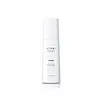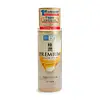What's inside
What's inside
 Key Ingredients
Key Ingredients

 Benefits
Benefits

 Concerns
Concerns

No concerns
 Ingredients Side-by-side
Ingredients Side-by-side

Water
Skin ConditioningPyrus Malus Fruit Water
MaskingBetaine
HumectantGlycerin
Humectant1,2-Hexanediol
Skin ConditioningMethylpropanediol
SolventHouttuynia Cordata Extract
Skin ConditioningLavandula Angustifolia Extract
Skin ConditioningRosmarinus Officinalis Leaf Extract
AntimicrobialOcimum Basilicum Flower/Leaf Extract
TonicAnthemis Nobilis Flower Extract
MaskingFoeniculum Vulgare Fruit Extract
EmollientCentella Asiatica Extract
CleansingFicus Carica Fruit Extract
HumectantDiospyros Kaki Leaf Extract
Skin ProtectingPortulaca Oleracea Extract
Skin ConditioningAlgae Extract
EmollientEclipta Prostrata Leaf Extract
Skin ConditioningPhellinus Linteus Extract
Skin ConditioningCordyceps Sinensis Extract
AntioxidantSparassis Crispa Extract
Emulsion StabilisingUlmus Davidiana Root Extract
Skin ConditioningAmaranthus Caudatus Seed Extract
Skin ConditioningCamellia Sinensis Leaf Extract
AntimicrobialCamellia Sinensis Leaf Water
MaskingAloe Barbadensis Leaf Juice
Skin ConditioningHydrogenated Lecithin
EmulsifyingArgania Spinosa Kernel Oil
EmollientSodium Hyaluronate
HumectantPolyglyceryl-10 Laurate
Skin ConditioningCarbomer
Emulsion StabilisingDipropylene Glycol
HumectantDiphenyl Dimethicone
EmollientTriethylhexanoin
MaskingTromethamine
BufferingButylene Glycol
HumectantPanthenol
Skin ConditioningBiosaccharide Gum-1
HumectantTocopheryl Acetate
AntioxidantBeta-Glucan
Skin ConditioningDimethicone
EmollientSqualane
EmollientHydrogenated Polyisobutene
EmollientDipotassium Glycyrrhizate
HumectantBifida Ferment Lysate
Skin ConditioningPolyglyceryl-10 Myristate
Skin ConditioningIsononyl Isononanoate
EmollientPolyglyceryl-10 Stearate
Skin ConditioningDisodium EDTA
Caprylic/Capric Triglyceride
MaskingCetearyl Alcohol
EmollientStearic Acid
CleansingButyrospermum Parkii Butter
Skin ConditioningPolyglyceryl-2 Dipolyhydroxystearate
Skin ConditioningFructooligosaccharides
HumectantLecithin
EmollientCellulose Gum
Emulsion StabilisingCeramide NP
Skin ConditioningHydrolyzed Hyaluronic Acid
HumectantInulin Lauryl Carbamate
Emulsion StabilisingDisodium Stearoyl Glutamate
CleansingSodium Hyaluronate Crosspolymer
HumectantHyaluronic Acid
HumectantPalmitoyl Pentapeptide-4
Skin ConditioningHydrolyzed Sodium Hyaluronate
Skin ConditioningPolysorbate 20
EmulsifyingParfum
MaskingPentylene Glycol
Skin ConditioningEthylhexylglycerin
Skin ConditioningWater, Pyrus Malus Fruit Water, Betaine, Glycerin, 1,2-Hexanediol, Methylpropanediol, Houttuynia Cordata Extract, Lavandula Angustifolia Extract, Rosmarinus Officinalis Leaf Extract, Ocimum Basilicum Flower/Leaf Extract, Anthemis Nobilis Flower Extract, Foeniculum Vulgare Fruit Extract, Centella Asiatica Extract, Ficus Carica Fruit Extract, Diospyros Kaki Leaf Extract, Portulaca Oleracea Extract, Algae Extract, Eclipta Prostrata Leaf Extract, Phellinus Linteus Extract, Cordyceps Sinensis Extract, Sparassis Crispa Extract, Ulmus Davidiana Root Extract, Amaranthus Caudatus Seed Extract, Camellia Sinensis Leaf Extract, Camellia Sinensis Leaf Water, Aloe Barbadensis Leaf Juice, Hydrogenated Lecithin, Argania Spinosa Kernel Oil, Sodium Hyaluronate, Polyglyceryl-10 Laurate, Carbomer, Dipropylene Glycol, Diphenyl Dimethicone, Triethylhexanoin, Tromethamine, Butylene Glycol, Panthenol, Biosaccharide Gum-1, Tocopheryl Acetate, Beta-Glucan, Dimethicone, Squalane, Hydrogenated Polyisobutene, Dipotassium Glycyrrhizate, Bifida Ferment Lysate, Polyglyceryl-10 Myristate, Isononyl Isononanoate, Polyglyceryl-10 Stearate, Disodium EDTA, Caprylic/Capric Triglyceride, Cetearyl Alcohol, Stearic Acid, Butyrospermum Parkii Butter, Polyglyceryl-2 Dipolyhydroxystearate, Fructooligosaccharides, Lecithin, Cellulose Gum, Ceramide NP, Hydrolyzed Hyaluronic Acid, Inulin Lauryl Carbamate, Disodium Stearoyl Glutamate, Sodium Hyaluronate Crosspolymer, Hyaluronic Acid, Palmitoyl Pentapeptide-4, Hydrolyzed Sodium Hyaluronate, Polysorbate 20, Parfum, Pentylene Glycol, Ethylhexylglycerin
Water
Skin ConditioningButylene Glycol
HumectantHydroxyethyl Urea
HumectantPentylene Glycol
Skin ConditioningPPG-10 Methyl Glucose Ether
Skin ConditioningDipropylene Glycol
HumectantDiglycerin
HumectantTriethyl Citrate
MaskingPEG-32
HumectantCarbomer
Emulsion StabilisingPEG-75
HumectantPhenoxyethanol
PreservativeGlycosyl Trehalose
Emulsion StabilisingDisodium Succinate
MaskingSorbitol
HumectantPropanediol
SolventSodium Hyaluronate
HumectantHydrogenated Starch Hydrolysate
HumectantDiethoxyethyl Succinate
SolventPotassium Hydroxide
BufferingSuccinic Acid
BufferingDisodium EDTA
Polyquaternium-51
Skin ConditioningCaprylhydroxamic Acid
Hydroxyethylcellulose
Emulsion StabilisingXanthan Gum
EmulsifyingSodium Acetylated Hyaluronate
HumectantAphanothece Sacrum Exopolysaccharides
AbsorbentLactococcus/Hyaluronic Acid Ferment Filtrate
Hydroxypropyltrimonium Hyaluronate
Sodium Hyaluronate Crosspolymer
HumectantWater, Butylene Glycol, Hydroxyethyl Urea, Pentylene Glycol, PPG-10 Methyl Glucose Ether, Dipropylene Glycol, Diglycerin, Triethyl Citrate, PEG-32, Carbomer, PEG-75, Phenoxyethanol, Glycosyl Trehalose, Disodium Succinate, Sorbitol, Propanediol, Sodium Hyaluronate, Hydrogenated Starch Hydrolysate, Diethoxyethyl Succinate, Potassium Hydroxide, Succinic Acid, Disodium EDTA, Polyquaternium-51, Caprylhydroxamic Acid, Hydroxyethylcellulose, Xanthan Gum, Sodium Acetylated Hyaluronate, Aphanothece Sacrum Exopolysaccharides, Lactococcus/Hyaluronic Acid Ferment Filtrate, Hydroxypropyltrimonium Hyaluronate, Sodium Hyaluronate Crosspolymer
 Reviews
Reviews

Ingredients Explained
These ingredients are found in both products.
Ingredients higher up in an ingredient list are typically present in a larger amount.
Butylene Glycol (or BG) is used within cosmetic products for a few different reasons:
Overall, Butylene Glycol is a safe and well-rounded ingredient that works well with other ingredients.
Though this ingredient works well with most skin types, some people with sensitive skin may experience a reaction such as allergic rashes, closed comedones, or itchiness.
Learn more about Butylene GlycolCarbomer is a polymer of acrylic acid. Its main role is to create a gel consistency.
A high amount of carbomer can cause pilling or balling up of products. Don't worry, most products contain 1% or less of carbomer.
Dipropylene Glycol is a synthetically created humectant, stabilizer, and solvent.
This ingredient helps:
Dipropylene glycol is technically an alcohol, but it belongs to the glycol family (often considered part of the ‘good’ alcohols). This means it is hydrating and gentle on skin unlike drying solvent alcohols like denatured alcohol.
As a masking agent, Dipropylene Glycol can be used to cover the smell of other ingredients. However, it does not have a scent.
Studies show Dipropylene Glycol is considered safe to use in skincare.
Learn more about Dipropylene GlycolDisodium EDTA plays a role in making products more stable by aiding other preservatives.
It is a chelating agent, meaning it neutralizes metal ions that may be found in a product.
Disodium EDTA is a salt of edetic acid and is found to be safe in cosmetic ingredients.
Learn more about Disodium EDTAPentylene glycol is typically used within a product to thicken it. It also adds a smooth, soft, and moisturizing feel to the product. It is naturally found in plants such as sugar beets.
The hydrophilic trait of Pentylene Glycol makes it a humectant. As a humectant, Pentylene Glycol helps draw moisture from the air to your skin. This can help keep your skin hydrated.
This property also makes Pentylene Glycol a great texture enhancer. It can also help thicken or stabilize a product.
Pentylene Glycol also acts as a mild preservative and helps to keep a product microbe-free.
Some people may experience mild eye and skin irritation from Pentylene Glycol. We always recommend speaking with a professional about using this ingredient in your routine.
Pentylene Glycol has a low molecular weight and is part of the 1,2-glycol family.
Learn more about Pentylene GlycolSodium Hyaluronate is hyaluronic acid's salt form. It is commonly derived from the sodium salt of hyaluronic acid.
Like hyaluronic acid, it is great at holding water and acts as a humectant. This makes it a great skin hydrating ingredient.
Sodium Hyaluronate is naturally occurring in our bodies and is mostly found in eye fluid and joints.
These are some other common types of Hyaluronic Acid:
Learn more about Sodium HyaluronateSodium Hyaluronate Crosspolymer is a type of hyaluronic acid. In fact, it is modified version of hyaluronic acid.
The structure of Sodium Hyaluronate Crosspolymer allows it to stay in the skin's top layer for a longer period of time. This allows for even more hydration and humectant action than hyaluronic acid.
These are some other common types of Hyaluronic Acid:
Learn more about Sodium Hyaluronate CrosspolymerWater. It's the most common cosmetic ingredient of all. You'll usually see it at the top of ingredient lists, meaning that it makes up the largest part of the product.
So why is it so popular? Water most often acts as a solvent - this means that it helps dissolve other ingredients into the formulation.
You'll also recognize water as that liquid we all need to stay alive. If you see this, drink a glass of water. Stay hydrated!
Learn more about Water